Top Story: Transportation
A closure heard ’round the world
June 6, 2011
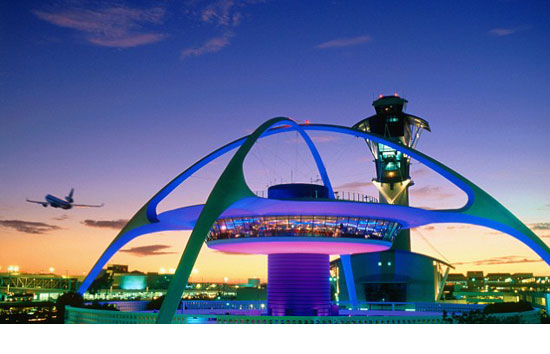 In most big cities, a detour is just a detour. Not in a world capital like Los Angeles.
In most big cities, a detour is just a detour. Not in a world capital like Los Angeles.
When a 10-mile stretch of one of the nation’s busiest freeways shuts down next month for a full weekend at the height of the summer tourist season, it won’t be enough for the locals to know that the 405 Freeway will be temporarily closed just north of Los Angeles International Airport. Travelers from around the globe will also have to be made aware that the freeway will be cerrará. And fermée. And geschlossen, 被 闭, and 폐쇄.
To that end, officials from LAX, Metro, Caltrans and other local organizations have created one of the world’s biggest phone trees to spread the word about the 53-hour closure that will start before midnight on Friday, July 15, and continue through the pre-dawn hours of Monday, July 18. The shut down through the Sepulveda Pass has been ordered as a safety precaution during demolition of the Mulholland Bridge, part of a massive freeway-widening project. (Full details are here.)
Notices of the closure are going out in eight languages via TV, print, radio, web and social media, and are expected to be further translated as they ricochet around the planet. A separate flyer is being prepared for airlines to forward to individual ticket holders.
The Los Angeles Convention and Visitors Bureau is alerting some 180,000 travel professionals, ticket brokers, hotels, restaurants, travel writers and individual tourists about the shut down via targeted newsletters, says spokesman Michael McDowell. Another 600,000 or so of the bureau’s Facebook friends and Twitter followers will also get the memo.
And for those who still manage to land here without knowing about the closure, LAX is preparing to call in extra troops of volunteer passenger information assistants to beef up the 13 information booths at the airport.
“Our goal is to ensure that passengers coming in and out plan ahead,” says Nancy Castles, public relations director for LAX, which is expected to see more than 170,500 travelers per day during that weekend, including some 52,500 international tourists.
About 40% of these travelers will connect to other flights. And many of those remaining in the region will likely rely on cabbies, shuttle operators, local friends or relatives who by then will hopefully know to use detours, says Castles. But for others, she adds, delays and unfamiliarity with L.A. will be a serious source of frustration.
“If we take the traffic analysts at their word, the 405 will have gridlock for 28 miles north of the 101 and 24 miles south of the 10 if they don’t get 70% of the cars off the freeway that would normally drive it on a summer weekend,” she says. “And if everyone is trying to go east or west on the Santa Monica Freeway, that’s going to back up beyond downtown L.A.”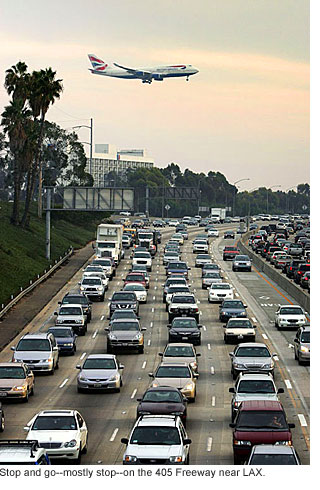
Heading that off is a big job, Castles concedes, but not nearly as big as it was during the 1984 Olympics, when logistical bulletins had to be gotten out without the benefit of text messaging, social media and the Internet.
“Time is on our side and, this time, technology is on our side,” Castles says.
Julie Valentine, director of corporate services in the Los Angeles office of the travel agency Altour, says the firm is aware that “traffic is going to be hellish.” But Altour’s booking system, she says, allows the agency to notify clients directly and offer alternative booking times if their travel dates are flexible.
The Los Angeles visitors bureau, meanwhile, already has issued advisories to its offices in the U.K., Germany, Japan, Korea, Australia, China and Miami, which serves the Americas. The organization also has a special link on its website to the 405 closure.
Looking on the bright side, bureau spokesman McDowell says the closure actually is well-timed because “happily there are no major conventions on those days and we’re not aware of any significantly large tour groups. But we are getting the word out to the tour operators to avoid the 405.”
His group is recommending tour destinations during the closure that can be reached through Metro’s transit system, such as Downtown L.A., Hollywood and Universal Studios. The visitor’s bureau also is working with hotels throughout the region, particularly those popular with international travelers, including the Luxe Hotel Sunset Boulevard and the Hotel Angeleno, both of which are within the affected area of the 405.
Reginald Archambault, general manager at the Luxe, says reservation clerks are advising guests of the closure in advance. But so far, he says, those fair warnings haven’t put a dent in bookings. “This is just one segment of a long project,” he says, “so I don’t think people are completely surprised.”
L.A.’s first line of tourism ambassadors—airport cabbies and limo drivers—seem less sanguine about how all this will unfold. Will Hebler, senior director of sales and marketing for Yellow Cab of Los Angeles, says that while fares out of LAX shouldn’t be as impacted as those in the areas around Brentwood and Mulholland, “it’s going to affect dispatchers because they’re going to have to find ways from Point A to Point C.”
Elton Silva, owner-operator of a small limo company based in Willowbrook, says that although much of his business is airport-based, he hopes to avoid the 405 altogether that weekend.
“It’s not going to be worth it,” he says. “We do a lot of fixed-rate business, and this means we’ll have to spend a bunch of hours and waste a lot of time and gas sitting in traffic. And it’s going to be hard to find a shortcut because everybody will be looking for the same thing.”
Officials at SuperShuttle, meanwhile, say they’re meeting this week to map alternative routes to popular destinations. (As a side note, they’re reassuring travelers that the more circuitous routes will not mean higher SuperShuttle fares.)
Of course, one option would be for travelers to choose airports other than LAX. Castles says local tourism officials won’t be suggesting that. But they are asking everyone to be prepared.
“We want people to know they need to allot plenty of time once they get here,” says Castles. “Don’t plan to land at 1 p.m. on a Sunday and be on your cruise ship by three, even if that’s what you’re used to. If you’re coming in domestically and thinking, ‘Well, I only need 90 minutes or whatever to get to that wedding’, allow more time than you normally would. Don’t cut it close.”
Posted 6/2/11
Plan now for huge summer 405 closing
May 17, 2011
Los Angeles, you’ve already lived through plenty—from detours to demolition—as the 405 Sepulveda Pass project carves out a 10-mile northbound carpool lane between the Westside and the San Fernando Valley.
Well, you ain’t seen nothing yet.
After a couple of hours of demolition prep work beginning at 10 p.m. on July 15, the 405 Freeway will be closed in both directions—from Getty Center Drive to the 101—for 53 straight hours so that the south side of the Mulholland Bridge can be demolished. The freeway will be closed all of Saturday and Sunday, and will not reopen until 5 a.m. on Monday, July 18.
Updated 5/27/11: The latest plans call for the 405 Freeway to be closed northbound from the 10 Freeway to the 101. The southbound freeway will be closed from the 101 to the Getty Center Drive offramps. Full details are here.
With a half million or so vehicles moving along that stretch of the 405 during a typical July weekend, the closure has the potential of becoming a midsummer night’s nightmare for motorists heading to LAX, the beach or other destinations. But, with enough planning and advance notice, Metro officials say that the worst can be averted.
“This is manageable as long as the public cooperates. They’ve got a lot of summer plans and we don’t want them to be surprised,” said Metro spokesman Marc Littman. “If you can stay home, great. If you don’t have to drive, great.” And if you do have to get behind the wheel, follow the officially marked detours, which by that point will have been widely publicized.
Already, Metro is gearing up for a major blitz to raise public awareness of what will almost certainly be one of the project’s most disruptive weekends. (The other will come when the freeway is closed again for the demolition of the north side of the bridge some 11 months after.) Ads in local newspapers are expected to start running next week, and a press conference—the first of many outreach activities— is scheduled for May 23.
Getting out the word is a big job, given the magnitude of the closure, which may be the largest of its kind through such a heavily traveled stretch of freeway. “I think this is bigger than anything in memory,” Littman said.
In an email to elected officials Thursday, Metro CEO Art Leahy cited the 1984 Olympics—when Los Angeles streets and freeways moved amazingly well, despite widespread predictions of gridlock and other traffic horrors—as an example of how the region can get through a major transportation headache, given enough early warning.
The 1960 Mulholland Bridge is one of three bridges being demolished and rebuilt during the project. Demolition work on the Sunset and Skirball bridges took place over a series of nights, and was managed without such a lengthy closure of the entire freeway. In the case of the Mulholland Bridge, officials say its steepness makes the weekend-long closure necessary to protect passing motorists.
In addition to the 10-mile carpool lane and the modernized bridges, the $1.034 billion project also is widening underpasses, building 18 miles of sound and retaining walls, and creating new or improved ramps, including new “flyover” ramps at Wilshire Boulevard.
“There’s short-term pain, but long-term gain,” Littman said.
Posted 5/13/11
Bikes make tracks on Metro trains
April 13, 2011
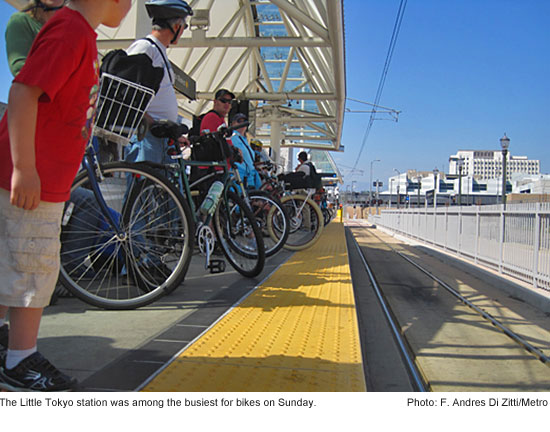 When Metro volunteers checked out the bike-toting crowds on downtown transit platforms Sunday morning, a thought straight out of “Jaws” leapt out at them:
When Metro volunteers checked out the bike-toting crowds on downtown transit platforms Sunday morning, a thought straight out of “Jaws” leapt out at them:
We’re gonna need a bigger train.
Sunday’s CicLAvia ride through Los Angeles streets was not just a test of the city’s ability to embrace a car-free existence for a few hours. It also was a test of Metro’s ability to cope with the largest congregation of bicycle commuters it’s ever faced, as thousands turned to public transportation to get them to and from the 7.5 mile route.
And—while it’s certain that many riders encountered delays, crowded train cars or both—it’s clear that the event was a milestone in the agency’s evolving track record of accommodating bicycles aboard its subway and light rail trains.
“I think it was a great opportunity to show that bikes and commuters and trains can all coexist,” said Andres Di Zitti, a Metro transportation planner who took part in the event as a volunteer and photographed some of the action. “This year, there were many more people and we were able to respond quickly…As we got to downtown, and saw the big turnout and the platforms starting to fill up, we called the operations managers and they sent longer trains out. It was definitely a good learning experience for us.”
Bruce Shelburne, a director in Metro operations, was on the receiving end of many of those phone calls. His staff was able to respond by quickly adding extra cars to trains on the Red, Purple and Gold lines—doubling capacity in some cases. They also had a couple of standby trains available, and those were pressed into service as well.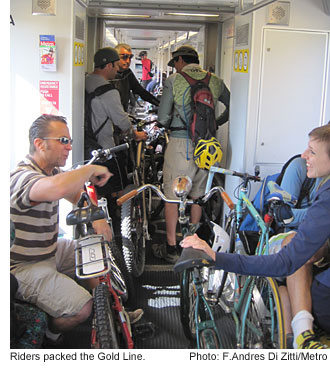
“We handled a pretty stressful day,” Shelburne said. “There’s no transit agency in the world that could have processed the amount of bikes that we had out there, period. I haven’t heard any complaints yet. I’m sure we’ll get some. But overall, it was a positive experience.”
Joe Linton, a longtime bike activist and one of CicLAvia’s organizers, said Metro did a good job of making more room for cyclists on its trains during the event. “I heard that some trains were very crowded—which is a good problem to have,” Linton said.
Sunday’s CicLAvia was the city’s second, and two more are in the works, tentatively scheduled for July 10 and October 9. Both will follow the same basic route, although a “spur” to the USC/Exposition Park area may be added, along with a Chinatown segment.
At the same time, Metro is considering plans to open up its trains for more bike commuters every day—not just CicLAvia Sundays.
Bikes currently are banned from Metro trains during peak commuting hours. That could change under a proposal set to go before Metro’s Operations Committee on April 21. The committee also will consider whether to spend $950,000 to remove some seats from light rail cars to make more room for bicycles. Seats already have been removed from Metro subway cars, Shelburne said.
Carving out more room for bikes and other items onboard the trains is a testament to changing commuting habits. “Back in 1990, the biggest thing we ever saw on a train was a briefcase,” Shelburne said. “Now everybody takes their life’s belongings with them.”
Accommodating cyclists by allowing them to ride the trains anytime could carry more than just symbolic value, according to a staff report urging reversal of the peak-hour ban.
“Elimination of time restrictions would allow unfettered access to the rail system,” the report said. “This would encourage more people to ride transit knowing that they would be allowed to begin and end their trips using bicycles; reduce their carbon footprints as more cars come off the road and increase MTA ridership leading to a more sustainable environment.”
Although CicLAvia was a special event, it offered insights into how bikes and trains can coexist better day in and day out, Shelburne said.
“Every time we do this event, we find some things that were done wrong,” Shelburne said. A biggie: “Passengers need to understand they cannot block doors on the trains. We have to probably provide a little more education.”
Goodbye, car. Hello, CicLAvia.
April 7, 2011
 Bobby Gadda wants to take your bike.
Bobby Gadda wants to take your bike.
Don’t worry—you’ll get it back. But Los Angeles County’s top “bike valet” and his team will be keeping a close eye on it while you take a breather from Sunday’s CicLAvia—a 7.5 mile, 5-hour free-for-all along city streets usually clogged with cars.
Gadda’s a true believer in the concept; he traveled to Bogotá in 2009 to check out the original ciclovía, in which streets in the South American city are closed to cars every Sunday to allow bikes and pedestrians to roam freely. And he joined a small, pioneering group of other L.A. activists who took the idea and, well, rolled with it.
Los Angeles’ first CicLAvia in October drew tens of thousands of participants and was widely hailed as an instant, improbable hit in a town where automobile culture has long ruled the roadways.
“I was really nervous,” Gadda said. “I thought not enough people would show up. It was amazing. It was just so much fun, seeing all the people who are usually too timid to ride bikes out there.” Indeed, families and once-in-a-blue-moon cyclists made up a good chunk of the crowd.
Sunday’s repeat performance of the free event—from 10 a.m. to 3 p.m. on a route that stretches from East Hollywood to Boyle Heights—is intended to draw participants on bikes, skateboards, strollers and feet to experience Los Angeles in a totally unexpected way.
“It’s not just a bike ride. The idea is to get out there and enjoy the city,” Gadda said. “I’m really looking forward to all of the spontaneous, fun things that happen.”
There are food-related itineraries and historic building-spotting possibilities along the route. Some people have organized a dodge ball game. Others are planning a grapefruit harvest in Koreatown. A book club reading by L.A. Times architecture critic Christopher Hawthorne is set to meet on the 7th Street overpass above the 110 Freeway—along with other more impromptu happenings. “I’ve heard that people will be out there shooting each other with water guns. Last year, a marching band showed up,” said Gadda, who also remembered a giant papier-mâché bull being rolled out and painted by the crowd in October.
And, adding to the communal nature of the event, pop-up groups have organized to ride together along “feeder routes” from various points around town, including Culver City/Palms, Mar Vista, the Fairfax District, UCLA and the San Fernando Valley.
Gadda, who rolled the route last time on his “tall bike”—one frame welded atop another—said that taking away the cars also lowered the decibel level dramatically. “The most amazing thing for me the first time was just how quiet it was,” he said.
Of course, one person’s urban oasis can be another’s public transportation headache. Metro has announced a number of bus detours for affected lines; it also has a list of transit lines providing easy access to the event. (Details on both are here.)
Gadda, 26, who studied philosophy and biology at Reed College in Oregon, is originally from bicycle-friendly Portland. But he said he didn’t become “radicalized” on the subject of integrating bikes onto urban streets until he moved to L.A. three years ago and confronted the traffic here.
After working for a software company in Long Beach, he joined the staff of the Los Angeles County Bicycle Commission, where he now runs the organization’s bicycle valet program.
 On Sunday, Gadda, who’s also a member of CicLAvia’s board of directors, will be hauling out the program’s really long bike racks—large enough to accommodate 200 bicycles—and overseeing the bike valet team in Little Tokyo, outside the Japanese American National Museum.
On Sunday, Gadda, who’s also a member of CicLAvia’s board of directors, will be hauling out the program’s really long bike racks—large enough to accommodate 200 bicycles—and overseeing the bike valet team in Little Tokyo, outside the Japanese American National Museum.
The bike valet is a new addition this year, and may be expanded to other locations in future CicLAvia events.
The free service (there’ll be a tip jar out) will enable participants to drop off their bikes, grab lunch or check out the sights.
Another free service will be offered Sunday by a squadron of “bike angels”—mobile mechanics ready to help riders fix flats, replace chains or adjust seats on their bicycles.
Jason Neville, an urban planner with the city’s Community Redevelopment Agency, served as a “bike angel” at the first CicLAvia. He stuck a hand-crafted sign on his bicycle and hawked his services “kind of like a peanut vendor at Dodger Stadium—Free bike repair! Free bike repair!”
He said his “customers” responded to his efforts with “this sort of Angeleno surprise that someone was just being nice and helping.”
That wasn’t the only surprise. Neville said he was struck by how quickly bike riders could get across the notoriously spread-out and congested metropolis when automobile traffic was taken out of the equation. “MacArthur Park is a 20-minute bike ride from Boyle Heights,” Neville said. “Hollywood is a 10-minute bike ride from downtown.”
And like Gadda, he was impressed by the silence of the streets. “It was very peaceful,” he said. “It was a glimpse of what Los Angeles can be.”
Posted 4/7/11
A sharp U-turn on Mulholland
March 3, 2011
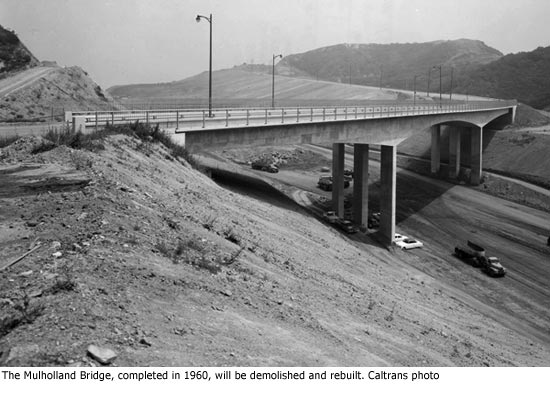
In the end, it was a bridge too far.
A short-lived plan to build a new Mulholland Bridge before tearing down the existing one as part of the I-405 Sepulveda Pass project has been scrapped, less than six months after it was announced to cheers from many in the project’s Community Advisory Committee. Project officials instead are reverting to their original plan of demolishing and rebuilding the existing bridge in two stages—although that’s expected to be costlier and more disruptive to traffic.
It’s also expected to take longer. Mike Barbour, who’s heading up the project for Metro, says that even though the freeway project as a whole remains on track to largely finish by May or June, 2013, the about-face will likely delay the Mulholland Bridge’s reopening for up to three months.
The change of plans comes after a Los Angeles city design review board weighed in on the project, asking for modifications and pushing Metro to go back to the drawing board to create an “extraordinary,” visually striking redesign of the bridge.
At the same time, the Brentwood Residents Coalition filed a series of objections to the project, arguing that the new-bridge plan would hurt the Mulholland corridor’s scenic quality and violate the California Environmental Quality Act if it went forward without a comprehensive environmental review. Letters expressing concern also came from the Bel Air Skycrest Property Owners Association and the Santa Monica Mountains Conservancy.
Their concerns included fears that the new configuration would interfere with the wildlife corridor around the bridge and break up Mulholland Drive by creating a “T-intersection” at the bridge, chopping the road into two segments.
The creation of an all-new Mulholland Bridge would break “the sinuous, continuous line of the beautiful and historic mother road,” Lois Becker, president of the Bel Air Skycrest group, wrote in a letter to the city’s Mulholland Scenic Parkway Specific Plan Design Review Board.
Toni Lewis, an architect on the design review board, said members had not set out to block the new-bridge plan and had made reasonable recommendations to Metro that could have been worked through.
The look of the proposed new bridge, developed in consultation with the project’s Community Advisory Committee, had been intended to mimic the existing structure, completed in 1960. But Lewis said too little consideration had been given to designing something better to befit one of the city’s landmark roadways.
“This is something that’s important and we’re treating it like the overpass at Overland, which it’s not,” she said. “I just thought that it was a total missed opportunity to leave something [the city] could be proud of.”
Metro said the design panel’s recommendations, along with concerns that it might be sued by the residents’ coalition, prompted it to reverse course rather than confront potential delays in court and in the design process.
“Unfortunately, we don’t have the luxury of time,” Yvette Rapose, Metro’s community relations manager for the project, said in a Feb. 25 letter to interested parties. Her letter said the agency was doing so even though it was confident that it had been on “firm legal ground” and would have prevailed in a court fight.
The $1.034 billion project is a Metro-Caltrans collaboration to add a 10-mile northbound carpool lane to the 405, along with other improvements. As part of the design-build process, Metro has been regularly meeting with the project’s Community Advisory Committee, made up of representatives from residents’ groups in the surrounding areas.
The idea of minimizing disruption by building a new Mulholland Bridge before knocking down the old one grew out of a meeting with community members last summer, and was supported by many on the advisory committee, particularly those from Encino and Sherman Oaks.
“I think it’s unfortunate that the best solution didn’t come out of the process,” said Barbour, who’d previously estimated that the new-bridge approach on Mulholland could have saved from $4 million to $10 million. He said the majority of the project’s advisory committee members had favored the construction of a new bridge. “A lot of people were supportive. They just weren’t as vocal as the people who were non-supportive.”
“The long and the short of it is: here we are back at square one,” said Laurie Kelson, a member of the Community Advisory Committee, as well as vice president of the Encino Neighborhood Council and chair of its traffic and transportation committee. Kelson had supported the idea of building a new bridge before tearing down the old as a better way to ensure good emergency response times in the heavily-traveled area and to lessen the overall traffic impact of construction.
She said the process should have given more weight to the opinions of those who live closest to the affected area. “There’s something wrong with the process,” she said. Community representatives from “each segment of this project should really be making the more important decisions about their segment.”
Since the challenge to the new-bridge plan also came from within the Community Advisory Committee, there have been some tensions within the group. But nobody seems to feel that any bridges have been permanently burned. “Did I wish they never started this? Absolutely,” Kelson said, of the committee’s dissenters to the plan. “But certainly there are a lot of good people to work with.”
Wendy-Sue Rosen, a member of the Community Advisory Committee and also president of the Brentwood Residents Coalition, which challenged the new-bridge plan, predicted that the advisory committee would be able to put the differences of opinion behind them.
“We are all strong advocates and disagreement is part of the process. But we pull together when necessary for a common goal,” Rosen said in an e-mail. “I don’t think that the differences of opinion over the Mulholland Bridge will make it harder to work collaboratively with each other or with Metro to ensure the project moves forward in the least disruptive manner.”
Posted 3/3/11
Judge rejects Expo Line challenge
February 24, 2011
In a significant victory for the Expo Line light rail project, a Superior Court judge has turned away a legal challenge that could have delayed or permanently derailed the line’s final leg to Santa Monica.
Judge Thomas I. McKnew, Jr., ruling in a case brought by the group Neighbors for Smart Rail, found that the environmental impact review for the Expo Line’s second phase was sound.
“EXPO carefully made its decision concerning the project with its environmental consequences in mind,” McKnew said in his ruling, which was faxed to attorneys in the case Tuesday.
There is no evidence, the judge found, to support the neighborhood group’s claim that Expo manipulated the alternatives “so that the project would appear to be better from a cost and environmental standpoint than the other choices.”
Supervisor Zev Yaroslavsky, a strong supporter of the project and a member of the Expo construction authority’s board of directors, which approved Phase 2 of the project last year, called the decision “a major milestone on the road to finishing the second phase of the Expo light rail project from Culver City to Santa Monica.”
“The court’s ruling is thoughtful and thorough and validates the difficult and meticulous work that the Expo Light Rail Authority, its staff and consultants did to ensure that this project will be safe, environmentally sound and sensitive to the communities through which it will travel,” Yaroslavsky said.
When completed, the 15.2 mile line will provide access to many cultural and community venues in downtown and beyond, including USC and the beach. It is expected to carry 64,000 passengers a day, making it one of the most heavily used rail lines in the country, Expo officials said.
Proponents of the Expo Line, which is being financed largely with revenues from the voter-approved Measure R, note also that it will be a key conduit for workers commuting to the jobs-rich Westside.
Opponents in the Neighbors for Smart Rail group, which includes a number of local homeowners associations, say they are not against a rail system as such, but contend it should run underground for safety and quality of life reasons.
But the judge found that Expo officials had fully explored the alternatives to running at street level and were correct in rejecting those approaches. Going underground could have caused “disruption of gravity fed storm drains, potential flooding of underground stations, increased construction impacts…and finally considerable increase in costs ($224.3 million.)”
The judge added that an aerial structure design “would result in creating a large physical barrier bisecting the neighborhood, create construction impacts similar to the trench option and increase costs ($65.9 million) without significant reduction of other impacts.”
The project approach that was ultimately selected is better than the alternatives from environmental, efficiency and cost standpoints, the judge found.
“We will finally have an alternative to the awful traffic, and hopefully no more delays,” said Darrell Clarke, co-chair of Friends 4 Expo Transit, which supports the Phase 2 plan. “I’ve only been an advocate for this thing for 21 years.”
However, Neighbors for Smart Rail announced it would appeal the ruling and is “confident that the appellate court will review the plain facts of the case and find that the Expo environmental review was fatally flawed and must be corrected.”
The organization said in a statement that it “remains dedicated to making sure that key north/south streets such as Overland and Sepulveda are not blocked 24 times per hour, that West L.A. traffic is not edged closer to gridlock by an ill-conceived light rail plan, that children are not put at risk by trains running just feet from their schools and that first responders will not be hampered by blocked arterials in their efforts to save lives and property.”
The $930 million first phase of the project, running parallel to the heavily congested 10 Freeway from downtown to Culver City, is scheduled to be completed in early 2012. (An opening of some of the line will take place later this year.) The $1.5 billion second phase, to extend the line to Colorado and 4th Street in Santa Monica by 2015, is expected to begin some construction later this year, after a contract is awarded to build it in coming weeks.
Posted 2/23/11
Shed no tears for the last diesel bus
January 13, 2011
As Metro retired the last of its smog-belching diesel buses this week, the agency marked the occasion with all the hoopla befitting the end of an era. There was a press conference highlighting Metro’s now 100% clean-burning bus fleet, and an unceremonious towing-away of the last diesel dinosaur.
At the same time, the agency’s library took a moment to look back at a very different Los Angeles, when the first diesel buses made their appearance here in 1940.
At the time, the coming of those initial 72 buses was hailed as a breakthrough in speed and comfort.
“These coaches offer a new degree of smooth acceleration with no vibration or uneven motion,” according to a trade publication quoted in the library account. “Attractive interiors boast mohair upholstered seats, stainless steel fittings, spacious aisles and wide windows.”
But things were about to get a lot more uncomfortable for the breathing public in the City of Angels. And vehicle exhaust—from cars and those ballyhooed buses—eventually would prove to be a major culprit.
“The dawn of diesel didn’t bode well for Los Angeles,” the library’s article said. “Just a couple of years later, Angelenos began noticing something else around town besides their new fleet of buses with mohair upholstery. On July 26, 1943, L.A. suffered through its first day of ‘smog.’ ”
The article includes this link to historic photos from the UCLA Library documenting some of the worst moments of the smog era in Los Angeles.
With the departure of the last diesel bus, Metro becomes the only major U.S. transit agency with a bus fleet made up entirely of clean-burning alternative-fuel vehicles.
As recently as 1984, the agency’s fleet had included more than 3,300 diesel buses. Its transition away from diesel started in 1993, when Metro’s Board of Directors decided to start buying only alternative fuel clean air buses.
Today, the agency has 2,221 compressed natural gas buses, six gasoline-electric hybrids and one electric bus. The switch to natural gas has meant a drop in greenhouse gas emissions of nearly 300,000 pounds a day, compared to what would be emitted by diesel buses, the agency said.
Metro’s blog The Source, meanwhile, has the lowdown on the fate that awaits Old Number 3004.
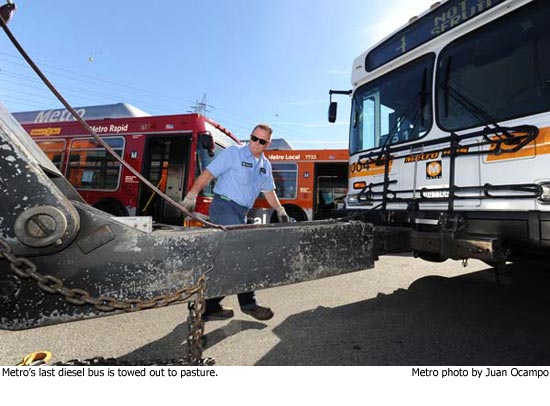
Posted 1/13/11
How Westside subway got back on track
October 28, 2010
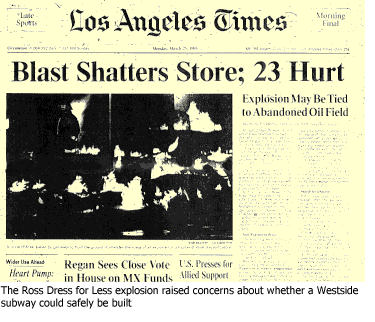 Twenty-five years ago, a methane gas explosion ripped through a Ross Dress for Less store in the Fairfax District, injuring nearly two dozen people and delivering a seemingly fatal blow to plans to build a subway along Wilshire Boulevard to the Westside of Los Angeles.
Twenty-five years ago, a methane gas explosion ripped through a Ross Dress for Less store in the Fairfax District, injuring nearly two dozen people and delivering a seemingly fatal blow to plans to build a subway along Wilshire Boulevard to the Westside of Los Angeles.
The area was designated a “methane gas hazard zone” and Congress moved swiftly to outlaw tunneling through the area.
Today, however, the subway is back. The Metropolitan Transportation Authority board on Thursday approved a locally preferred route for the Westside Subway Extension that would send the project through the once-banned territory. The board’s approval now moves the project into the final environmental review process.
“This is an historic day,” said Supervisor Zev Yaroslavsky, a member of Metro’s Board of Directors. “This is the first time in my lifetime, and in probably all of our lifetimes, that we have gotten this close, this far along the road to extending and building a public mass transportation line through the Wilshire Corridor.
“For all of the vicissitudes that we’ve had over the past quarter century,” Yaroslavsky said, “we finally are at the point where this is becoming more of a reality than a dream.”
The subway’s resurgence—one of the more remarkable comebacks in American transit history—came about in part because of more than two decades’ worth of technological advances, along with the findings of an expert peer review panel which led Congress to lift its prohibition at the urging of Rep. Henry A. Waxman.
“People had all but left it for dead,” said Raffi Hamparian, Metro’s government relations manager. He pointed to the evolution of new tunneling technology and the vote of confidence by the American Public Transportation Association’s peer review panel as two of the key turning points in the subway saga.
In a November 2005 report, the panel of nationally-acclaimed experts said it had unanimously determined that building the Westside subway, with proper procedures and technologies, poses a risk “no greater than other subway systems in the United States.”
As improbable as it might have seemed at the time, that March 24, 1985 blast, which sent flames shooting through fissures in sidewalks with its force, ended up becoming something of a galvanizing event in construction safety.
“We now have the benefit of hindsight. We also have the benefit of new technology,” said Dennis Mori, Metro’s executive officer of construction project management. He said lessons learned during the construction of Metro’s Red Line subway and Gold Line Eastside Extension will provide valuable guidance for tunneling through the gassy territory of the Wilshire corridor.
One of the biggest game-changers—literally—may be the “Closed Face Earth Pressure Balance” tunnel boring machine.
“The machine, fully assembled, is about the length of a football field,” Mori said. First used in L.A. during the Gold Line extension project that started in 2004, the machines offer operators greater control over how fast ground is displaced as they dig, lessening the risk of settlement and sinkholes.
The machines also can be outfitted with what Mori describes as “very robust ventilation equipment” to help workers avoid gas exposure while tunneling through the sometimes-challenging terrain that the Westside subway would need to traverse.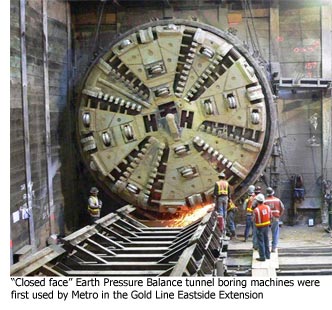
Dr. Geoffrey Martin, a USC professor emeritus and member of Metro’s tunnel advisory committee, said that advances in “slurry shield” tunneling technology also have made it safer for workers to remove gassy soil.
On Thursday, the board adopted a preferred route that would extend the Purple Line subway along Wilshire from Western Avenue to the V.A. Hospital. The route’s cost, about $4.2 billion in 2009 dollars, could rise to more than $5 billion by the project’s completion. All of the potential routes considered as part of the subway’s draft environmental impact process would have needed to pass through “an area characterized by oil and gas fields,” according to the project’s draft environmental report. “Therefore, hazardous subsurface gasses pose a significant hazard for all of the Build Alternatives.”
The draft environmental report listed a number of abandoned or idle oil wells in the area, also noting the La Brea Tar Pits’ “extensive tar sands” and high methane and hydrogen sulfide gas levels.
The Metro board also feels it can move forward with confidence because of years of successful underground projects since the Ross Dress for Less explosion.
Those include work by the city of Los Angeles’ Bureau of Engineering, which successfully tunneled through “almost 30 miles of similar gassy formations.” The bureau was commended by Cal-OSHA for successfully completing “the most dangerous tunnel job in the history of the state.”
More recently, LACMA’s new two-level subterranean garage, which opened in 2008, generated voluminous studies that have been provided to Metro to assist in the subway planning process. Under the proposed route, the Westside subway’s Fairfax station would be located next to the museum.
LACMA President and Chief Operating Officer Melody Kanschat said the museum, given its location beside the Tar Pits, approached the $33 million garage project cautiously, with substantial geological advance work, including boring into the ground to test for gas levels across eight acres at the site. And, with paleontological specimens in abundance—including a spectacular mammoth named Zed—great care also needed to be taken to safely preserve the fossils for the neighboring Page Museum.
She said that the Ross Dress for Less blast—once a dramatic catalyst for new building practices and technologies—seemed to be an increasingly distant memory for members of the public who weighed in on the garage project.
“Honestly, the methane is not as much of a concern for the general public as it was then,” Kanschat said. “The public was actually more concerned about the paleontological discoveries.”
That wasn’t the case, however, at Thursday’s Metro meeting.
The possibility of an underground explosion was among the many potential hazards cited by speakers from Beverly Hills, who turned out Thursday to voice their concerns about the possibility of tunneling beneath the city’s high school. While no final decisions have been made, the route under the high school is one of the options to be studied further under the plan adopted by the board.
Lisa Korbatov, vice president of the Beverly Hills Board of Education, read from a letter to Metro Board Chairman Don Knabe from a lawyer representing the school district:
“It is well known that the high school is located on a working oil field approved many years ago, with oil wells located onsite. The process of tunneling through the hazardous area underneath the high school imposes unacceptable explosion and cancer risks to the high school’s population”—risks, the letter said, that will never go away.
The Beverly Hills residents’ opposition centers on the placement of the subway’s Century City station. They oppose building a station on Constellation Boulevard because it would require tunneling under Beverly Hills High School. They favor an alternative that would run under Santa Monica Boulevard, which sits atop an earthquake fault. However, other speakers, from Westwood’s Comstock Hills neighborhood, spoke out in favor of the Constellation option.
Both options will be explored as part of the project’s final environmental review and preliminary engineering and design process. And, under a motion by Yaroslavsky that was adopted by the board in its vote Thursday, Metro staff was directed to fully explore all possible ramifications of the tunneling in Beverly Hills as well as from Century City to Westwood.
“Obviously, safety is the No. 1 issue for us,” Yaroslavsky said. “We will not build a tunnel that we believe is unsafe, whether it’s under the high school, or whether it’s under Santa Monica Boulevard or whether it’s under the residences in Westwood, or anywhere else in the County of Los Angeles.”
Another speaker, attorney Kenneth A. Goldman, called into question the safety of the machines Metro would use to build the subway, saying they had been linked to accidents in other countries, including Germany, Brazil, China and Korea.
But Metro board members and staff emphasized the safety records of recent local projects, including the Red Line to North Hollywood and the Gold Line Eastside Extension.
“In fact, on the Eastside Gold Line there wasn’t one single safety infraction for that entire period,” said Los Angeles Mayor Antonio Villaraigosa, a Metro board member whose 30/10 initiative is seeking to accelerate building of the Westside subway along with other projects in the region.
Still, as Thursday’s board meeting made clear, the 1985 explosion’s after-effects are not being forgotten.
“We need to know what we have at every step of the way,” Yaroslavsky said, “where there’s an oil shaft, where there’s a methane pocket…and mitigate it and ensure that when we build it, our construction workers are safe. The people who live around the construction are safe. And when we finish it, the people who ride it are safe.”
Posted 10/28/10




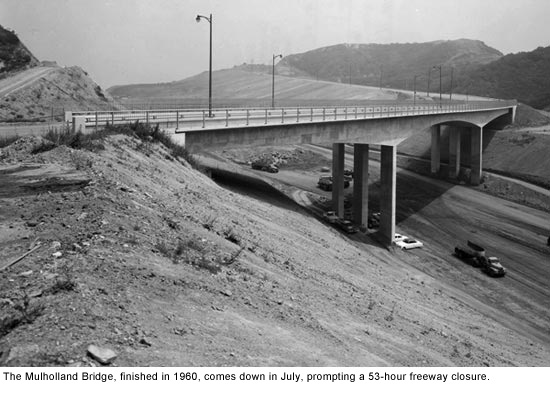
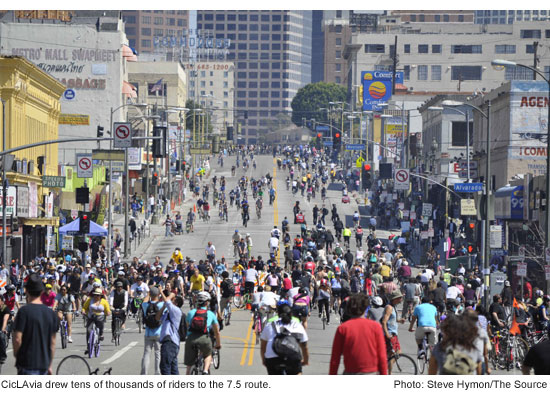
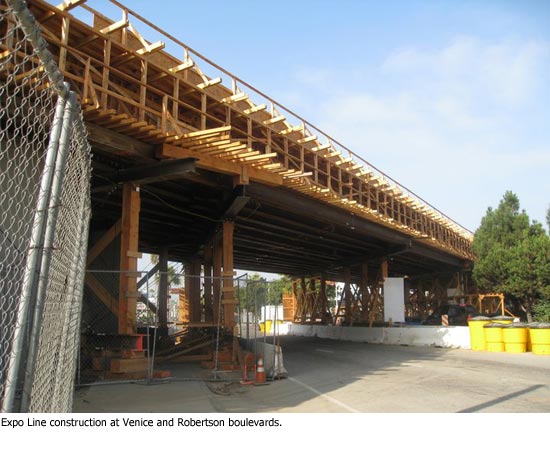








 405 bridge work causes a stink
405 bridge work causes a stink

